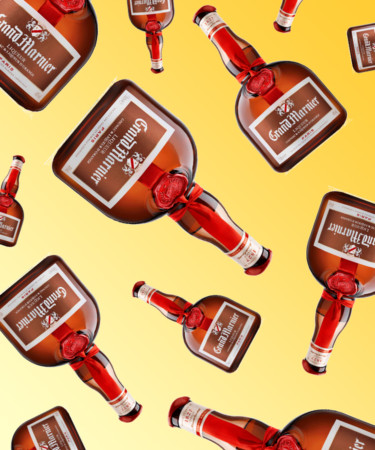
One of the best-known orange liqueurs, Grand Marnier is a Cognac-based spirit with aromas of vanilla and a toffee-like flavor that packs a boozy punch. A Gallic liqueur with immense history, it is just as at home in a Margarita as it is in a canonical French dessert.
What should you know about the spirit too savvy to be called anything but “grand”?
Here are 10 things to learn about Grand Marnier.
-
It’s A Heavyweight.
While most liqueurs range from 15-30 percent ABV, Grand Marnier comes in at a whopping 40 percent. That’s about 80 proof — essentially the equivalent of many full-fledged spirits, including Tito’s vodka, Don Julio tequila, and Bacardi rum.
-
Mr. Marnier Was A Real Person.
Grand Marnier was founded by Louis-Alexandre Marnier Lapostolle in 1880. His father-in-law, Jean-Baptiste Lapostolle, established what would become Grand Marnier’s first distillery when he began making fruit liqueurs outside of Paris in 1827. Louis-Alexandre came from a winemaking family in Sancerre and started out as an assistant to Jean-Baptiste’s son, Eugene. While working at the distillery, he had a revolutionary idea to pair Cognac with a then-exotic ingredient, oranges, in the Lapostolles’ laboratory. After 10 years of experimentation, Grand Marnier was born.
-
It’s Cognac, And Then Some.
Grand Marnier features brandy made from Ugni Blanc grapes from five Cognac crus, and is double-distilled in copper stills. It gets its orange notes from the Caribbean-grown “Citrus Bigaradia,” also known as the Seville or bitter orange.
-
It Was Enjoyed on the Titanic.
A bottle of Grand Marnier was reportedly discovered among the 5,500 artifacts salvaged from the 1912 Titanic wreckage.
-
Grand Marnier Remains A Family Affair.
Founder Louis-Alexandre Marnier became Louis-Alexandre Marnier Lapostolle when he married Jean-Baptiste’s daughter. Alexandra Marnier Lapostolle, a member of la famille’s sixth generation, has served as president of Marnier Lapostolle Inc. since 2008.
-
It Has Gone Global.
In 2016, the Campari Group — a beverage conglomerate with Campari, Aperol, Wild Turkey, Skyy Vodka, and Appleton Estate among its 50-plus-label roster — acquired a controlling stake in the company that owns Grand Marnier, Société des Produits Marnier Lapostolle S.A., for a cool $761 million.
-
It’s A Prominent Feature In Countless Classics.
Grand Marnier is a key ingredient in the classic Sidecar cocktail, made with brandy, orange liqueur, and fresh lemon juice. Adored for its ability to make Margaritas even better, the bittersweet liqueur is also found in the Cosmopolitan, Lemon Drop, and more.
-
The Original Grand Marnier Is Called Cordon Rouge.
The traditional Grand Marnier, 51 percent Cognac and 49 percent orange liqueur, is called Cordon Rouge (literally “red ribbon”) for the distinct embellishment adorning the bottle, held in place with a wax seal. Ubiquitous in bars across the country and best known for enhancing mixed drinks or as a floater in your favorite cocktail, Grand Marnier is also enjoyed sipped neat. While Cordon Rouge remains the brand’s most popular product, it now sells a number of other derivations.
-
Grand Marnier Produces Luxurious, Top Shelf Liqueurs.
The brand offers super-premium liqueurs to satisfy the most discerning palates, including Cuvée Louis Alexandre ($80), formulated with a blend of 12-15 year-old aged Cognacs with notes leaning toward pine and Earl Grey tea; Cuvée du Centenaire ($150), created in 1927 to celebrate the company’s 100th anniversary; Cuvée 1880 ($325), made from X.O. Cognacs from the Grande Champagne region to celebrate the company’s birth; and Quintessence ($800), the brand’s ultra-exclusive bottle featuring century-old Cognacs.
-
It Is Famously Flammable.
Grand Marnier is a key ingredient in Crêpes Suzette, an iconic French dessert made by topping a crêpe with a citrus liqueur sauce (enter: Grand Marnier) and flambéing it briefly. As legend has it, the dish was a happy accident created in 1895, when a young French waiter, Henri Charpentier, accidentally lit a chafing dish on fire while serving dessert to the future King Edward VII of England.
